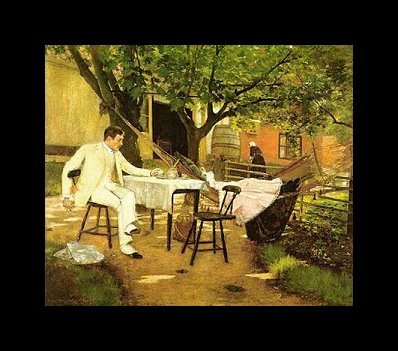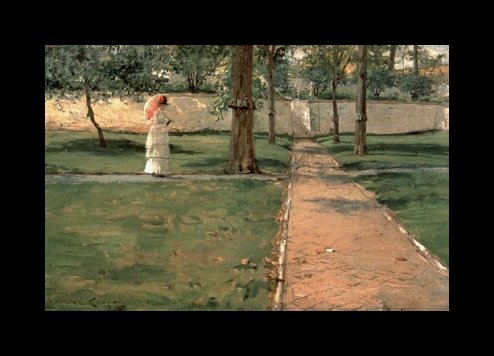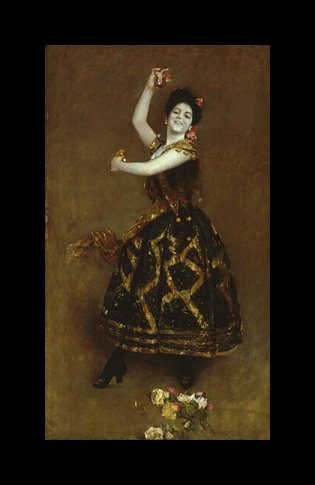William Merritt Chase (1849-1916)
Get a Merritt Chase Certificate of Authenticity for your painting (COA) for your Merritt Chase drawing.
For all your Merritt Chase artworks you need a Certificate of Authenticity (COA) in order to sell, to insure or to donate for a tax deduction.
Getting a Merritt Chase Certificate of Authenticity (COA) is easy. Just send us photos and dimensions and tell us what you know about the origin or history of your Merritt Chase painting or drawing.
If you want to sell your Merritt Chase painting or drawing use our selling services. We offer Merritt Chase selling help, selling advice, private treaty sales and full brokerage.
We have been authenticating Merritt Chase and issuing certificates of authenticity since 2002. We are recognized Merritt Chase experts and Merritt Chase certified appraisers. We issue COAs and appraisals for all Merritt Chase artworks.
Our Merritt Chase paintings and drawings authentications are accepted and respected worldwide.
Each COA is backed by in-depth research and analysis authentication reports.
The Merritt Chase certificates of authenticity we issue are based on solid, reliable and fully referenced art investigations, authentication research, analytical work and forensic studies.
We are available to examine your Merritt Chase painting or drawing anywhere in the world.
You will generally receive your certificates of authenticity and authentication report within two weeks. Some complicated cases with difficult to research Merritt Chase paintings or drawings take longer.
Our clients include Merritt Chase collectors, investors, tax authorities, insurance adjusters, appraisers, valuers, auctioneers, Federal agencies and many law firms.
We perform William Merritt Chase art authentication, appraisal, certificates of authenticity (COA), analysis, research, scientific tests, full art authentications. We will help you sell your William Merritt Chase or we will sell it for you.
An American painter with European training, William Merritt Chase was one of the foremost artists of his era. Born in Indiana, he became a prolific artists and teacher. Chase taught at the Art Students League and eventually opened his own school, The Chase School of Art in New York in 1896. Among his many students were Georgia O’Keefe and Charles Sheeler, and he often rubbed elbows with the American art elite. Chase was a very prominent social figure and was well known for being fashionable and keeping a studio filled with exotic artistic elements.
A master in oil and watercolor, he was also eclectic and ever changing. Due to his love of travel and unending quest for new artistic methods, Chase’s work took on a transformation mid-career. He painted both in America and abroad, and his methods took new shape as a result.
His early work is dominated by the dark color palate that he adapted while studying abroad in Munich. In the beginning he created mostly traditional portraiture, such as the “The Portrait of William Gurley Munson” (1868).

Portrait of William Gurley Munson
He was highly sought after for these soft and realistic portraits, done in the Classical style. However, after traveling to Venice and Holland, he discovered the use of light and became a master at it. He was able to produce realist light on hair, and shining through trees onto the grass like in this painting “Sunlight and Shadow”.

Sunlight and Shadow, 1884
This painting was revolutionary for him, and signaled his beginning as one of America’s first Impressionistic landscape painters. It was during this time that he began to use the Impressionists’ lighter color palate. He had also adopted the “plein-air” method of painting outdoors, and brought it with him to his school of teaching.
Chase is also noted as one of the first American painters to document leisure activities in recreational parks. Some of his landscape work of New York City’s parks are breathtaking, and are reminiscent of an era gone by. Ladies in bonnets with parasols strolled in the lush parks of New York City in his landscaping, far before the days of skyscraper backdrops and joggers in sweat suits. One such painting is “In Brooklyn Navy Yard”, which is the perfect combination of Realism and Impressionistic styling.

In Brooklyn Navy Yard, 1887
At times, Chase was accused by his critics of painting in too European a style. His landscaping series of real people in Brooklyn and Manhattan were an answer to this criticism, and his audience received this work well. He painted modern life of the day, and his work shows us a time before New York became the metropolis it is today.
Along with beautiful Classical portraiture, Chase also had a penchant for painting lively portraits, and was sought after for them. One can clearly see the difference in his styles by comparing and contrasting the playful “Carmencita” one of his most famous pieces with the traditional “Dorothy”, a portrait of his daughter. Both are spectacularly detailed, but the subjects and styling are almost completely different.

Carmencita, 1890

Dorothy, 1902
Chase was a family man, and used his wife and nine children as subjects for his work on a regular basis. He would also paint things in close proximity to him, such as his studio, his parents’ back yard, or New York City. During his career, he created more than 2,000 still-life, landscapes, portraits and interiors.
To this date, there are no records of a Chase painting ever being stolen. However, through his extensive travels, paintings could have easily been lost along the way, or sold abroad and never documented.
One of the most interesting aspects of Chase’s career is his influence on teaching other artists. He taught literally hundreds of students during this time, and the possibility of Chase collaborating with students is immense. Could there be a painting out there attributed to a lesser known artist who collaborated with Chase as a student? The possibility certainly exists, and only a trained eye could tell.
Today, William Merritt Chase’s work is exhibited in museums all over America. In his lifetime, he won a number of awards for his work, and grants and scholarships for students bear his name, and will always be known as a forerunner for American Impressionism.
If you believe you own a work of art by William Merritt Chase, contact Art Certification Experts. We authenticate, appraise, research and provide Certificates of Authenticity (COA's) for works by William Merritt Chase.
Reviews
1,217 global ratings
5 Star
4 Star
3 Star
2 Star
1 Star
Your evaluation is very important to us. Thank you.
